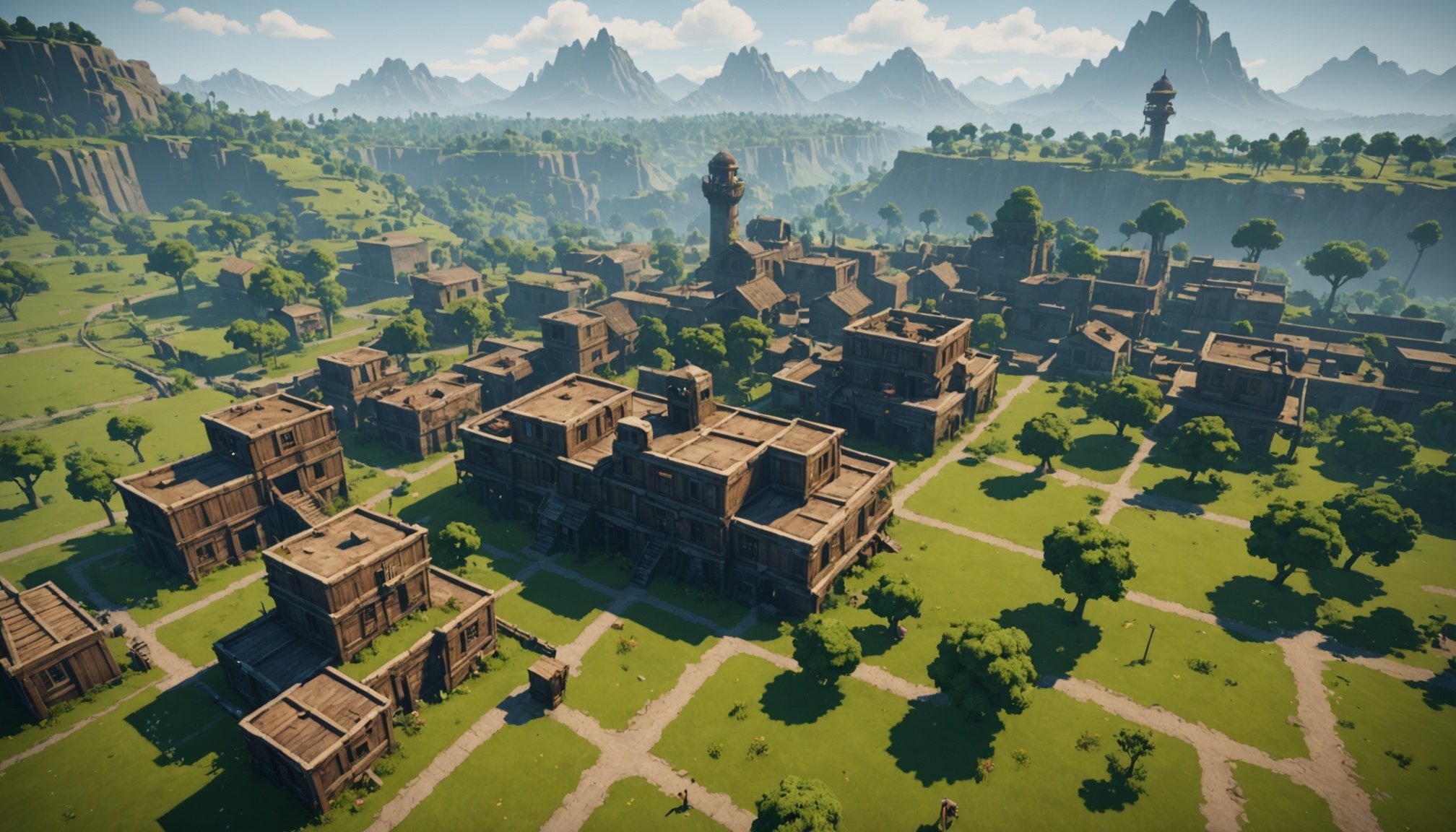Understanding Procedural Generation
Procedural generation is a method in game development used to create content algorithmically rather than manually. This technique is especially prevalent in open-world design, as it enables developers to craft expansive, varied worlds with minimal resources. Procedural generation operates on a set of rules or algorithms to dynamically produce game elements, such as landscapes, characters, or missions. It empowers developers to generate numerous permutations, thereby enhancing replayability and reducing repetitive tasks in game design.
Historically, procedural generation has its roots in early video games due to hardware limitations; developers sought efficient ways to create engaging experiences without extensive memory usage. Over time, this approach has evolved to suit modern game development, embracing advanced algorithms that provide unprecedented levels of detail and complexity. Games like “No Man’s Sky” and “Minecraft” showcase the potential for richly detailed, endless exploration.
This might interest you : Exploring the Hurdles of Achieving Authentic Water Physics in Fishing Simulation Games
Notably, procedural generation differs from traditional design methods, where each element is hand-crafted. While traditional design offers precision, procedural design offers scalability. This trade-off means while developers relinquish some control over the minutiae, they gain the capability to produce vast environments with unique experiences each playthrough, revolutionizing open-world design.
Advantages of Procedural Generation
One of the primary benefits of procedural generation within game development is its potential for significant cost-effectiveness. By automating the creation of various in-game elements, developers can drastically reduce the need for manually designed assets. This not only cuts down on labour costs but also accelerates production timelines, allowing teams to allocate resources to areas that may require more creative input.
Also to see : Exploring the Hurdles of Incorporating Real-World Physics into Space Simulation Games
The scalability of procedural generation ensures that games remain immersive and diverse, offering players expansive environments that are continually renewed. This method allows developers to craft worlds that are not only vast but also filled with unique, dynamically generated content. Players often find themselves exploring new terrains and encountering novel scenarios each time they dive into the game, maintaining excitement and engagement over prolonged periods.
Additionally, dynamic content generation can greatly enhance the player’s experience by offering fresh challenges and surprises without the need for frequent updates from developers. This can lead to increased player retention and enjoyment, as the game evolves seamlessly alongside their interactions. With procedural generation, developers can meet the growing expectations of gamers in a cost-effective and scalable manner, delivering robust and captivating experiences.
Disadvantages of Procedural Generation
While procedural generation offers thrilling possibilities, it’s important to recognise its limitations. A key drawback is the lack of uniqueness. When environments or scenarios are generated by algorithms, there’s often a risk of repetition. This repetition can lead to environments feeling somewhat impersonal or uninspiring over time, as they might lack the distinct, handcrafted touch that makes each game experience truly special.
Additionally, a significant challenge lies in crafting narrative depth. Procedural methods can struggle to create complex story arcs or emotional connections that are typically fashioned by humans. In gaming, narratives often drive player investment. When a game lacks narrative depth, even the most intricately designed worlds may fail to hold a player’s interest for long.
Another impact worth discussing is on player engagement. Environments that feel repetitive can reduce immersive experiences. Players could lose emotional connection and engagement if they perceive the world as generic. It’s like reading a novel with similar chapters; the story becomes predictable.
While procedural generation offers creative freedom, the technology must evolve to overcome these limitations and craft truly unique, engaging experiences.
Case Studies of Procedural Generation in Video Games
Procedural generation has become an integral component of modern game design, offering distinct advantages in terms of variety and replayability. This section dives into the procedural techniques employed in No Man’s Sky and Spelunky, both hailed as revolutionary in their respective genres.
In No Man’s Sky, the universe comprises a staggering 18 quintillion planets, each uniquely generated. This vast universe is created using mathematical algorithms that determine everything from landscape formations to vegetation. The game analysis of No Man’s Sky reveals a careful balance between randomness and player engagement, where discovery is a core element. Spelunky, on the other hand, excels in procedural level generation. Each gameplay run is unique due to dynamically generated layouts. This ensures unpredictability and maintains player immersion across multiple sessions.
Comparatively, games like The Legend of Zelda series, using traditional design frameworks, hold players’ hands through carefully crafted environments. While these offer meticulously detailed narratives, procedural generation provides a canvas of infinite exploration. Both methods have their merits, but procedural techniques can spark creativity, driving the gaming experience in unexpected and delightful directions.
Expert Insights on Procedural Generation
Procedural generation has become a transformative tool in game development, offering vast landscapes and endless possibilities without the hefty manual input previously required. Expert opinions from seasoned developers highlight its ability to create unique experiences, enabling games to be more immersive and diverse. This design consideration is now a pivotal part of crafting open-world environments where every playthrough can offer a new adventure.
Emerging trends in procedural generation technology are centred around complex algorithms that enhance realism and variability. Developers foresee an increased use of AI-driven systems to finely-tune environmental interactions and narrative elements. This evolution promises not only richer worlds but also smarter non-playable characters (NPCs) that can adapt to player choices in real-time.
Looking at the future trends, experts predict significant advancements in open-world game design, with procedural generation leading the charge. There is an expectation for more seamless player interaction, where player choices influence environments dynamically. The potential for collaboration between AI and procedural techniques might redefine user engagement, driving the creation of highly personalised game worlds.
As the industry embraces these trends, developers need to consider the balance between randomness and meaningful content to maintain player interest and satisfaction in procedurally generated worlds.
Balancing Procedural and Traditional Design Methods
In the constantly evolving landscape of game development, hybrid approaches that blend procedural and traditional design methods have become increasingly prevalent. These methods can offer substantial benefits when carefully integrated, allowing for more dynamic and immersive experiences.
One effective strategy in using hybrid approaches involves implementing procedural generation to create expansive worlds while retaining the narrative depth and artistry typically achieved through traditional techniques. This can be done by strategically utilizing procedural tools to generate large-scale environments, and then refining critical elements manually to maintain uniqueness and narrative coherence.
For best practices, developers should focus on designing best practices for procedural algorithms that emphasize flexibility and artistry. This might include developing modular systems that allow designers to adjust procedural parameters, giving them control over the final output. Successful integration ensures the richness of traditional storytelling isn’t lost in expansive open-world environments.
Design strategies should also involve iterative testing and feedback loops to fine-tune the balance between procedural generation and handcrafted elements. This guarantees the environment feels cohesive and purpose-driven, enhancing the player’s engagement. By adopting strategic design strategies, developers can harness the automated creativity of procedural systems while preserving the intricate touch of human ingenuity.











